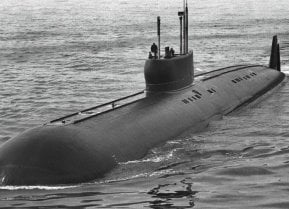Russia's Victor III-Class Submarine Had Just One Mission
At the height of the Cold War, the USSR introduced its latest Victor III-Class submarine to service. Its series of nuclear-powered attack ships built for the Soviet Navy were designed primarily to counter American capabilities at sea.
Russia’s Victor III-class sub - The Ultimate Profile: At the height of the Cold War, the USSR introduced its latest Victor III submarine to service.
Its series of nuclear-powered attack ships built for the Soviet Navy were designed primarily to counter American capabilities at sea.
The Project 671RTM/RTMK Shchuka (pike) submarines were launched at the Admiralty Shipyard in Leningrad beginning in the mid-1970s.
In total, 48 ships were constructed, the last remaining being in service with the Russian Navy.
An overview of the Victor-class:
Designated by the North Atlantic Treaty Organization (NATO) as the Victor-class, these submarines represented a huge leap in capabilities for the Soviet Navy.
Specifically, each ship in this class possessed sophisticated anti-submarine warfare abilities, a critical attribute meant to support their offensive and escort roles for the service.
The original Victor-class variant was developed in the late 1960’s. The Yorsh (Project 671) consisted of 16 ships. Each submarine was equipped with six torpedo tubes for launching Type 53 torpedoes and SS-N-15 mines and anti-submarine missiles could also be fired.
The subsequent Victor II-class ships entered service beginning in 1972. As the first Soviet ships to be fitted with raft mounting for acoustic quieting, the Victor IIs were designated by NATO as a different class initially than their sister variant ships.
The Victor IIs were quite formidable. However, their production stopped when the Victor III submarines were conceptualized.
Introducing the Victor III submarines:
The Shchuka (pike) Project 671 RTM/RTMK submarines were developed between 1979 and 1991. The Victor III ships were fitted with “cluster-guard” anechoic coatings, which were used to minimize noise levels to prevent detection.
Some analysts believe the Victor III's quietness was comparable to the USS Sturgeon-class SSNs. Another modification incorporated on these submarines were bow hydroplanes that could retract into the hull when on the surface or at high underwater speeds.
These submarines uniquely possessed two additional tubes for launching SS-N-16 missiles and Type 65 torpedoes.
The submarines could also carry other weapons, including SS-N-21 or SS-n-15 missiles and Type 53 torpedoes for smaller tubers. In total, 24 tube-launched weapons or 36 mines could be carried on the Victor III ships.

Specs & capabilities:
When NATO first became aware of the Victor III variant ships, intelligence agencies speculate that the distinctive pod positioned on the vertical stern-plane on the boats were used to house some sort of exotic silent propulsion system.
Two VM-4T nuclear reactors driving a sole steam turbine powered the submarines, generating 22.7 megawatts of energy.

As detailed by analyst Mark Episkopos, “Project 671RTM submarines later received a substantial armament upgrade in the form of the RK-55 Granat submarine-launched cruise missiles, featuring an operating range upwards of 2,000 kilometers and the option for a 200-kiloton nuclear warhead.”
Future Victor III variants were also modified to feature improved fire control and combat direction systems. The cutting-edge Medveditsa navigation system was designed to replace the older Sigma system incorporated on earlier Victor-class ships.
About the Author: Maya Carlin
Maya Carlin, National Security Writer with The National Interest, is an analyst with the Center for Security Policy and a former Anna Sobol Levy Fellow at IDC Herzliya in Israel. She has by-lines in many publications, including The National Interest, Jerusalem Post, and Times of Israel. You can follow her on Twitter: @MayaCarlin.
All images are Creative Commons.


